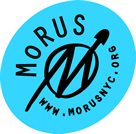Sitting Down to Talk Squatting With Homesteading Museum Founders
The Local East Village
Jared Malsin
March 7th, 2012
Sitting Down to Talk Squatting With Homesteading Museum Founders
After seven months of negotiations, the creators of the Museum of Reclaimed Urban Space have finally signed a lease and are busy fundraising, compiling photos and video, and renovating the storefront inside the legendary collective building C-Squat, where the East Village’s first squatting and homesteading museum will be housed.
The signing of the lease on Thursday with the Urban Homesteading Assistance Board marked the formal launch of the project, which is already staging what organizer Laurie Mittelmann calls “spontaneous tours” of squats, community gardens and other sites of street-level confrontation with police and developers over the control of urban space in the East Village since the 1970s.
On Tuesday, The Local visited the Museum’s dedicated video compiling facility (we were asked not to disclose its location), where two of the project’s 30 volunteers were hunched over computers logging video onto hard drives. (Time’s Up has donated over 400 hours of footage to the museum.) On one video, police were issuing a ticket to performance artist Reverend Billy during a 2006 demonstration.
During our visit, Ms. Mittelmann and co-director Bill DiPaola spoke about their vision and plans for the new museum.
The Local: What inspired the museum in the first place?
Bill DiPaola: We’re both volunteers with an environmental organization called Time’s Up. A lot of the stuff we worked on – getting more bicycling, community gardens, reclaiming public spaces – we have a lot of pictures, for 25 years. We have a lot of video. Somehow in history, the real story of the community, of direct action never comes out. So, we wanted to have a museum to tell the truth.
We’re an all-volunteer group. We have a history of trust with the community gardens because we helped save a lot of them in the past. A lot of the people we’re relying on – for the pictures, the video, for the access – are people that we know from the past of working in this community.
The Local: Were either of you involved in occupying buildings in the past?
DiPaola: Sure, I’ve been involved with that. When Time’s Up started in this neighborhood, we went to a lot of demonstrations, and we noticed that a lot of the squatters in the community would come to these demonstrations.
The squatters have gotten a bad rap. They have been involved in transforming this community in a great way. A lot of the buildings that are called squats have been amazing in letting people use their spaces to save the community gardens. There’s always been a connection between the buildings and the neighborhood.
The Local: Have you encountered any resistance from squatters who might view the squats as an ongoing project and might see a tension between that and a museum which is maybe more static?
DiPaola: Not yet. So far everybody’s been really friendly and willing to work with us. As I said, squatters have gotten a bad rap in the press, and with this museum, we’re working to change that. We got voted into a squat, which is unusual, so it shows they have some trust for us right off the bat.
The Local: Do you regard the museum more as an academic project, or an activist project, or both, or neither?
DiPaola: I don’t even look at it like that. Laurie’s more of an academic than I am. I’m more like a direct action, hands-on kind of person. So we’re complementing each other.
The Local: Do you have a sense of how close you are to completing your goal and opening the museum?
Mittelmann: It will depend on how people respond to our fundraising video. We need help, and we hope that people support us.
DiPaola: We were waiting [before circulating a fundraising appeal] to sign the lease with UHAB. It was a very difficult lease to sign. It took months to figure out how to do it. It’s a very unusual building, C-Squat. Everyone in the building has to vote during every decision. Also they kinda own the building, they kinda don’t. But we got the lease, and we’re going to start construction. Even today I’m going to try to go over there and do some construction.
Mittelmann: And they only have meetings once a month, so every time we brought up a new issue with them, we had to wait another month to hear their answer.
The Local: Has the emergence of the Occupy movement in September helped you?
DiPaola: Sure, because a lot more people in America now understand the connection. America is kind of run by corporations, and in other places around the world there is more of a connection to community, and the East Village has an amazing connection to community. They have community-run buildings, community-run community centers. Everybody gets to vote, it’s collectively run. The group that I work for, Time’s Up, has over a hundred volunteers. ABC No Rio runs off of volunteers. Bluestockings runs off of volunteers. It seems to be pulsing out from the East Village.
The Local: Can you say more about this idea of presenting history as a struggle between opposing forces, as opposed to simply a series of events?
DiPaola: That’s what’s interesting to show. Even when we did our latest tour, and we went into the community gardens, and these people who were the experts, they would say “Spitzer’s agreement saved the gardens,” and that’s true, but what led to Spitzer’s agreement was an incredible amount of people getting arrested, an incredible amount of direct action from the community, which seems to be left out in history.
